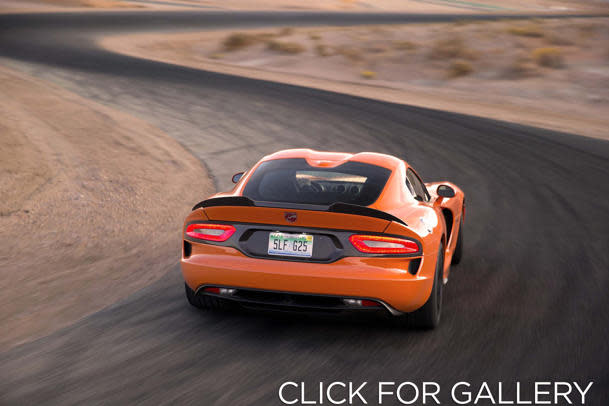 Motoramic
Motoramic2014 SRT Viper TA, when too much is just enough: Motoramic Drives
Readying for action at the Willow Springs racetrack in Rosamond, Calif., the message from SRT, Chrysler’s performance arm responsible for the fearsome Viper, was simple: “We’re not trying to compete with the Corvette.” It seemed ironic; given the track-focused Viper TA was rushed into production because the Corvette ZR1 outpaced the latest snake in a Motor Trend comparison test last year.
So forgive me for being dubious.
The similarities, on the surface, appear evident: Both are muscular sports cars made by two of Detroit's giants. Both seek a direct driving experience instead of the high-dollar finesse of their European counterparts. And both cost far less than the performance figures suggest.
But there is one difference: One gaping, cavernous imbalance that cannot be ignored. In total, roughly 30,000 Vipers have been sold, while the Corvette boasts figures surpassing 1.3 million. There are plenty of reasons for this: Firstly, the Corvette debuted in 1953. The Viper didn’t exist until 1992. And let’s not forget that the ‘Vette features a more diverse lineup, meeting various sized wallets; a Viper comes with a 640 hp V-10 and stickers well north of $100,000, whether you like it or not.
And that’s because SRT wants to keep the car exclusive. It’s not a machine for everyone, and they know that. But they did aim to sell 2,000 of the revamped snakes in its first year. That won’t happen. Last month it was announced that 426 Vipers had been sold since its launch in February, and that 565 machines were sat gathering dust in dealer’s lots. That’s not a great ratio, and it caused SRT to scale back production.
Why is it not selling? Well, the Viper still boasts a reputation as a killer, only enhanced by a platoon of magazine testers who claim the car is too difficult to drive fast. I contend that fiercely; the Viper does exactly as you tell it. If you drive it well, it will reward you. But if you do something wrong, it will punish you. It won’t bite unless provoked.
However, inexperienced drivers still think of the Viper as intimidating. And initially, it is, as it should be. It boasts a reputation, a presence, a fear. It is a Viper. But once you get comfortable in the car, it requires a serious mistake, or an insane act of foolishness, to result in a catastrophe — at least when discussing the latest generation with its array of stability and traction control settings.
So, back to the track, where I prepared to wrestle the new Viper TA (Time Attack), the most track-focused of the current generation Vipers, costing around $120,000. It’s no ACR, but it does have a front splitter and rear wing that add 300 lbs. of downforce at 150 mph; new Brembo two-piece rotors with 13.5-percent more swept area and larger brake pads; a ton more camber for better tire wear on track and additional grip; stiffer springs, and solid sway bars (versus hollow) that bolster torsional stiffness 30 percent. The under-hood cross piece ditches its aluminum makeup, too, in favor of carbon fiber.
Despite those efforts, the TA tips the scales at 3,390 lbs., around 40 lbs. heavier than the Viper SRT with the optional Track Pack, according to SRT engineers. That weight stems primarily from the heavier rotors and solid bars.

 Yahoo Autos
Yahoo Autos 

